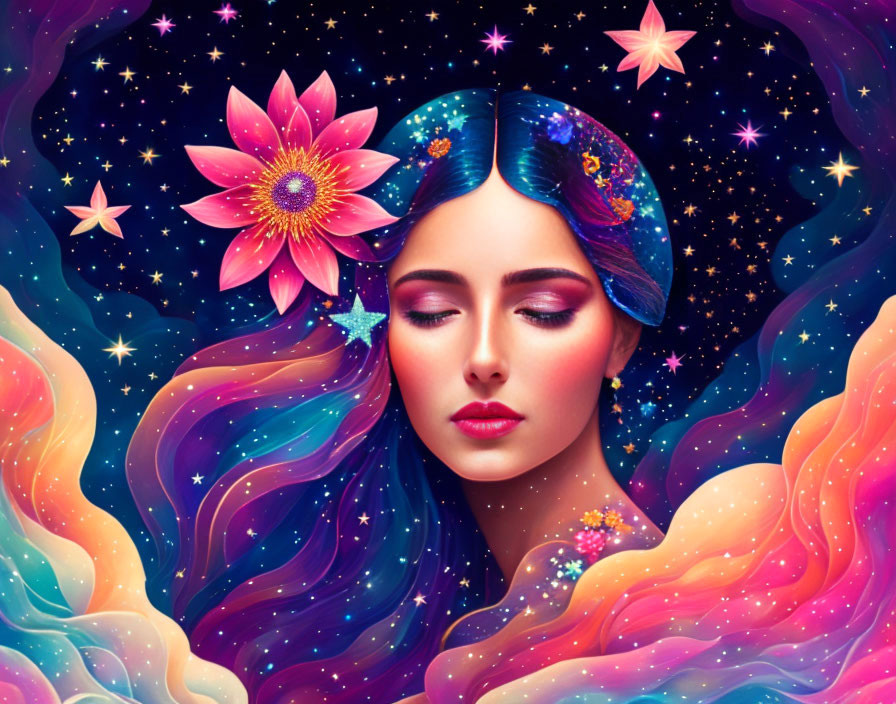
What is visionary art?
Visionary art definition:
Visionary art is a genre of art that focuses on spiritual and mystical experiences, deep exploration of human psyche often involving altered states of consciousness or depiction of wide states of awareness. It is characterized by a highly detailed, surrealistic style that often incorporates beautiful symmetrical patterns, vivid colors, dreamlike states, spiritual and mystical experiences, religious or psychological symbols and fantastic imagery. Visionary art is often associated with spiritual movements such as shamanism, Buddhism and new age spirituality, and it is frequently inspired by experiences with plant medicine, meditation, dance, yoga and other forms of spiritual practice. It can also incorporate spiritual practices, cultural heritage and symbolism. Therefore the term ‘visionary artist’ is often used interchangeably with ‘spiritual artist’ and ‘psychedelic artist’ because all three groups of artists explore deeper states of consciousness that may exist beyond our everyday perception of reality. In my opinion, visionary art is a more encompassing term than the psychedelic art but the spiritual art is even more encompassing that the visionary art because most art can be called ”spiritual’ since it addresses our emotions.
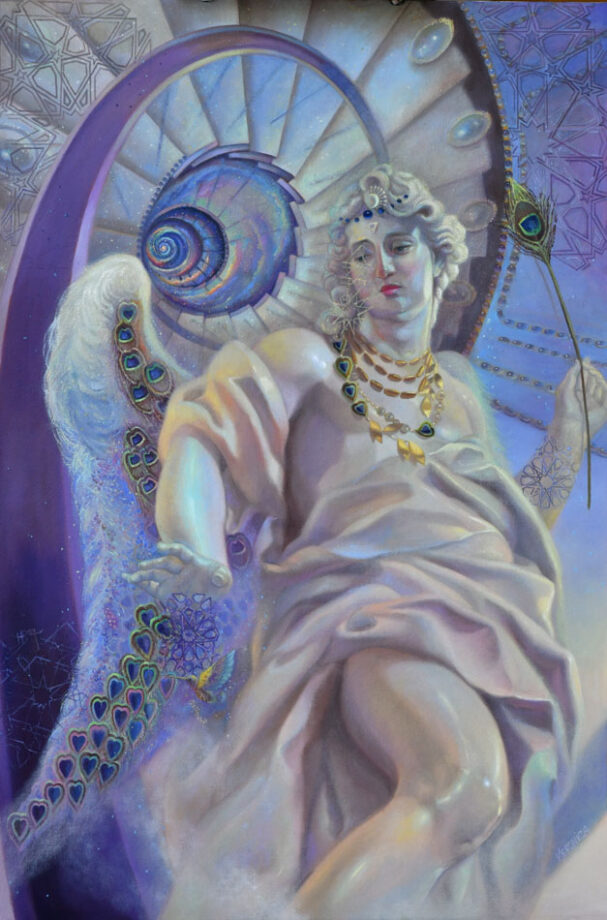
Visionary art history
The term “visionary art” as we understand it today was not commonly used in the 19th century, but there were artists who created works that might be considered visionary in nature during that time period. For example, the Symbolist movement that emerged in the latter half of the 19th century often incorporated mystical and visionary themes into their work. Artists such as Gustave Moreau, Odilon Redon, and Arnold Böcklin created works that were highly symbolic and often depicted dreamlike or otherworldly scenes. William Blake (1757–1827) was an English poet and artist who is considered to be one of the most important visionary artists of the 19th century. His work often explores themes of religion, mythology, and the imagination.
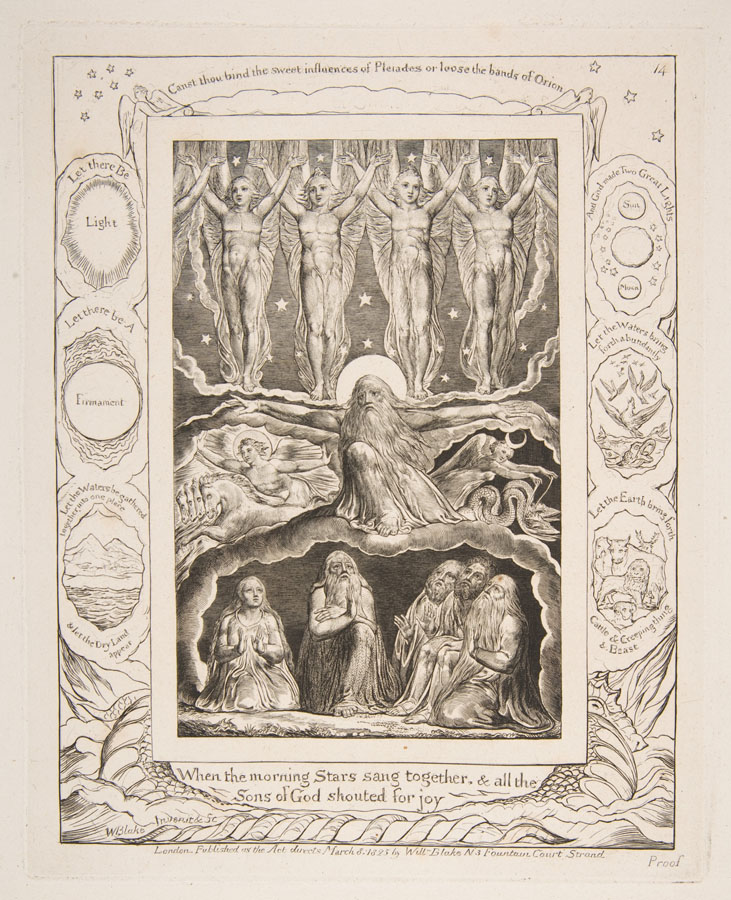
Similarly, the Pre-Raphaelite Brotherhood, which was active in the mid-19th century, often created works that were highly detailed and rich with symbolism. Many of their works were inspired by literature and mythology, and they often depicted scenes from the imagination or the realm of fantasy. While these artists might not have been explicitly identified as “visionary artists,” their surreal paintings often explored the same themes and ideas that are central to the genre of visionary art that emerged in the 20th century. A Swedish artist, Hilma af Klint (1862–1944) is considered to be one of the pioneers of visionary art in visionary art history movements. She created a series of abstract paintings that she called “Paintings for the Temple.”
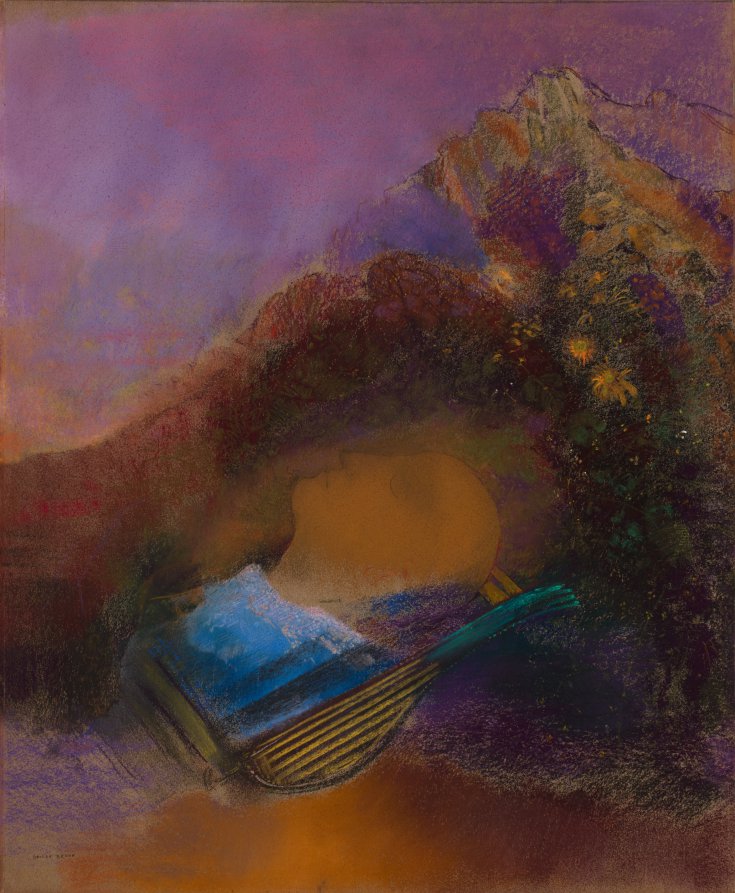
The term “visionary art” was used by the art critic and scholar Roger Cardinal in the 1970s to describe the work of the late 19th-century symbolic artists – William Blake, Gustave Moreau, and Odilon Redon. The term was also used in the 1960s by the art critic Lawrence Alloway to describe a genre of art that was inspired by spiritual or mystical experiences. Today, the genre encompasses a wide range of artists, styles, and media, from painting and sculpture to digital art, AI art, video art and multimedia installations.
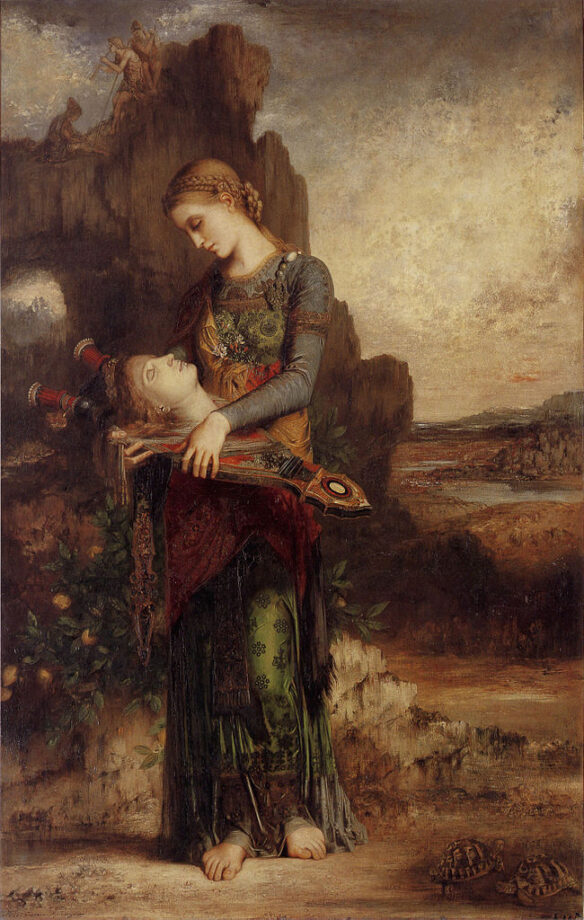
Carl Jung‘s ideas about the collective unconscious and archetypes have had a significant influence on the development of visionary art symbolism. Jung believed that the human psyche contains universal patterns and symbols that are shared across cultures and time periods ( like the shared term for a ‘mother’). He called these patterns and symbols archetypes. Many visionary artists have drawn on Jung’s ideas to explore the deep layers of the psyche and to tap into the archetypal imagery that resides within the collective unconscious.
Visionary artists often use symbols and imagery that are drawn from a variety of cultural and spiritual traditions, as well as from their own personal experiences and visions. For example, artist Alex Grey has said that his artwork is inspired by his experiences with LSD and DMT, as well as by his studies of various spiritual traditions, including Buddhism and Hinduism. Some visionary artists, use their artwork as a means of exploring the deep layers of the psyche and uncovering hidden aspects of the self. Both Carl Jung and visionary artists have the shared interest in exploring the depths of the human psyche and tapping into the archetypal imagery that resides within the collective unconscious.
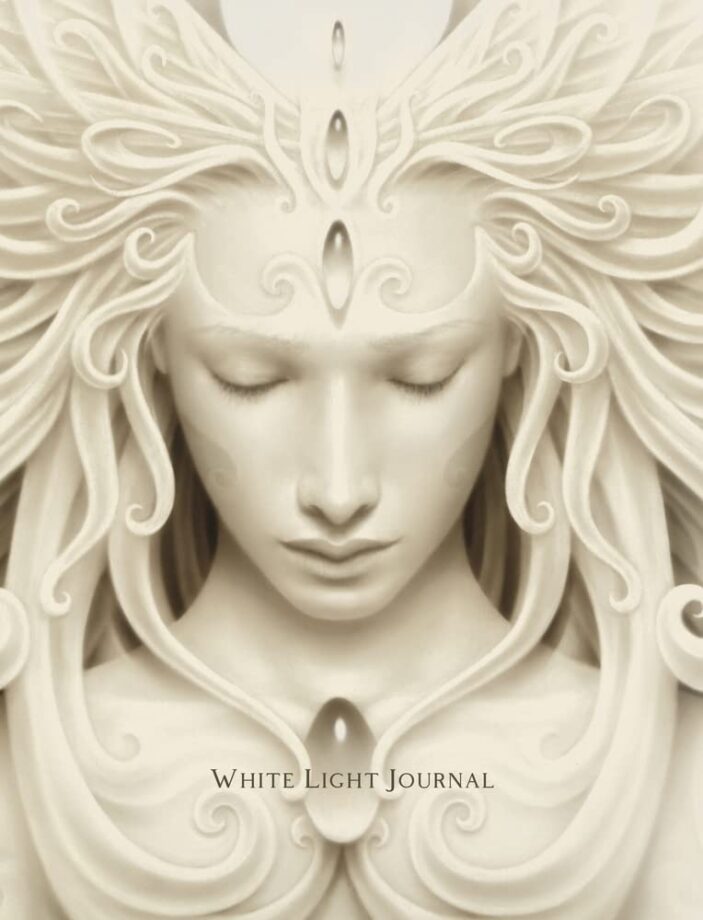
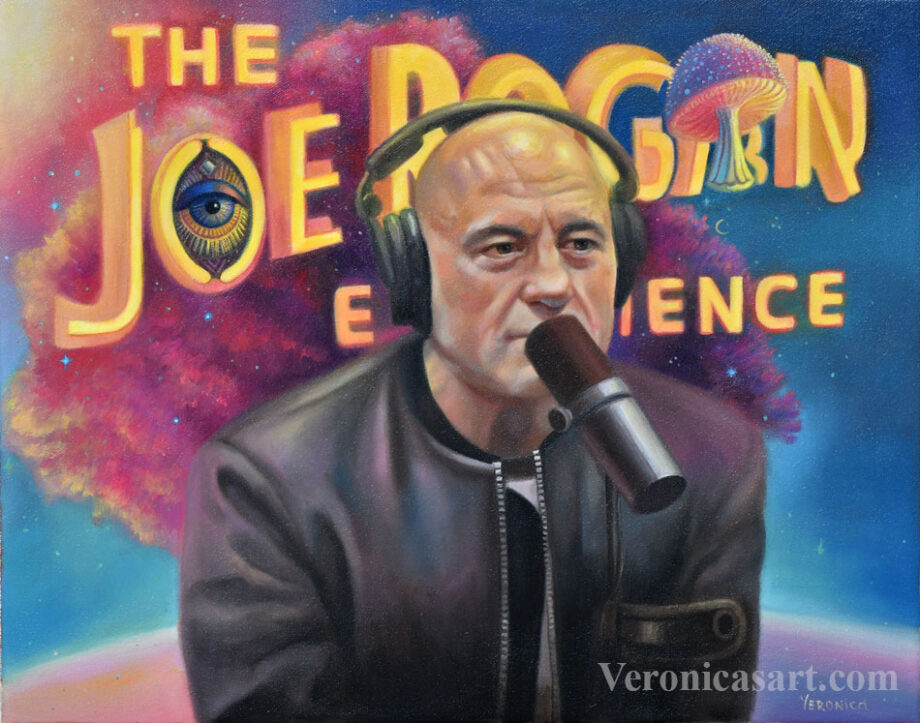
“The graveyard is the richest place on earth, because it is here that you will find all the hopes and dreams that were never fulfilled, the books that were never written, the songs that were never sung, the inventions that were never shared, the cures that were never discovered, all because someone was too afraid to take that first step, keep with the problem, or determined to carry out their dream.”
Les Brown
Who are contemporary, famous visionary artists?
There are several famous visionary artists although this term is often used interchangeably with psychedelic artists and spiritual artists. The list is constantly evolving as new artists emerge and new styles develop. Here are a few well-known visionary artists in no particular order:
- Alex Grey – Grey is perhaps one of the most famous visionary artists. He’s also known as one of contemporary psychedelic artists. His highly detailed visionary paintings often depict human anatomy and consciousness in surrealistic and spiritual ways using repeated patterns and designs seen on a psychedelic trip.
- Allyson Grey is a life-long spiritual partner and wife of Alex Grey. Her art is quite different from her husband’s although they often work together on artistic projects, such as CoSM -Chapel of Sacred Mirrors. She paints psychedelic patterns and designs that don’t involve the human form.
- Rob Gonsalves is a Canadian artist who passed away in 2017. He created imaginative realism paintings that could also fall into a category of visionary art painting or contemporary surrealism art and even op art. His talent was to realistically convey the sense of magic and wonder in painting that he achieved visually with some optical illusion techniques. Technically his art showed a lot of prep work and influences of the surrealists, op art, and architectural drawing.
- Ernst Fuchs – Fuchs was an Austrian painter and printmaker who was associated with the Vienna School of Fantastic Realism. His work is characterized by a highly detailed, ornate style that often incorporates religious and mystical themes.
- Amanda Sage – Sage is a contemporary visionary artist who creates vibrant figurative art that explore the connection between humanity and the natural world. She also paints vibration and patterns layered over the figure to show spiritual dimension of human beings.
- Android Jones – Jones is a digital, psychedelic artist who creates highly detailed works that explore themes of consciousness and spirituality.
- Mati Klarwein – Klarwein was a painter who was associated with the psychedelic movement of the 1960s. His work is characterized by a highly detailed, surrealistic style that often incorporates religious and mythological themes.
- Roger Dean – his art features many light, mythical, landscapes that are welcoming and fantasy-like.
- Veronica Winters – fine artist interested in exploring wider states of consciousness in painting and colored pencil drawing using color harmonies, patterns and symbols.
- Luke Brown – psychedelic artist that also incorporates the symbolism of shamanic cultures and Asian religions.
- Carey Thompson – is a contemporary psychedelic artist that utilizes geometric themes and colors in his artwork.
- Laurence Caruana
- Autumn Skye Morrison
- David Heskin
- Orphné Achéron is a contemporary artist inspired by antiquity, mythology and medieval times. Orphné, “Nymph of the Darkness” was the wife of Acheron, branch of the Styx, carrying the souls of the dead… This name chosen by the artist evokes Eternity, Mythology, immersion in mysterious depths. The artist combines indian ink and gold leaf to create black-and-white-and-gold, figurative drawings of strength, melancholy, contemplation, chaos, peace and mystery. Orphne also relies on visual elements taken from Egypt, Roman art and Medieval era to create dark fantastic creatures and figures that also carry the light.
- There are numerous digital artists that you can find on Instagram who create art with a combination of programs and AI. Check out digital art by visionary artists on Instagram: Danjc.Imagine, Surreal.lifelines, CrystalDreams.AI, Astrodeum.
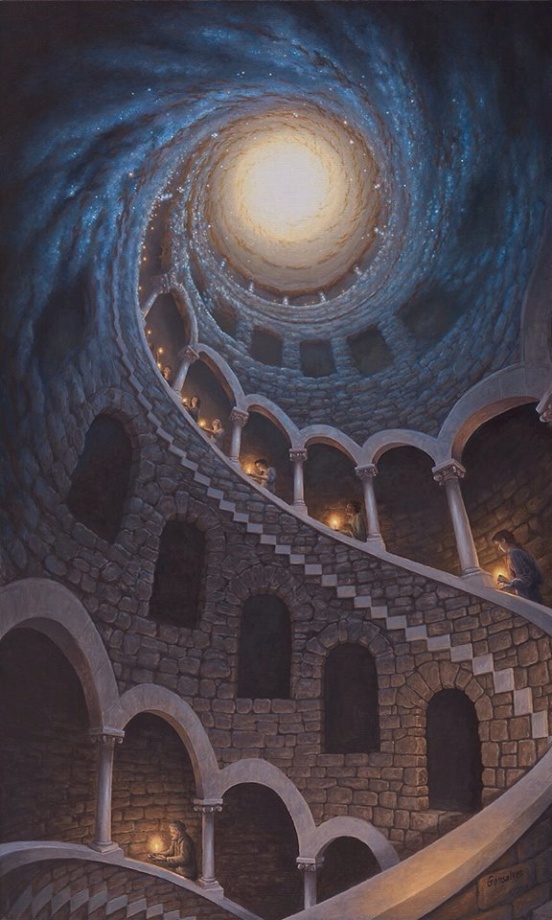
Visionary art symbolism. What do artists want to say with visionary art?
Visionary art is often characterized by a deep sense of exploration, inquiry, and experimentation, and by a willingness to push the boundaries of what is considered “art” and “reality” in order to explore new dimensions of experience and consciousness. Some of the common themes found in visionary art include:
- Exploration of consciousness: Many visionary artists use their work as a means of exploring the nature of consciousness, and the ways in which altered states of consciousness can give rise to new forms of perception and understanding.
- Spiritual or mystical experiences: Many visionary artists draw inspiration from spiritual or mystical experiences, and use their work to communicate the profound insights and transformative experiences that can arise from such encounters.
- Environmental or social issues: Some visionary artists use their work as a means of raising awareness about environmental or social issues, and to inspire action and change.
- Healing and transformation: Most visionary artists believe that their work can serve as a tool for healing and transformation, both on an individual and a collective level.
- Uniting the personal and the universal: Visionary artists seek to create works that bridge the gap between the personal and the universal, and that speak to the shared human experience in a way that is both deeply personal and universally resonant.
Visionary art themes, styles and subjects:
There are several themes or ideas that are commonly associated with visionary art. These include:
- Surrealistic imagery: Visionary art often features strange and dreamlike imagery that is not found in everyday life. The images are often highly detailed, and may feature bizarre combinations of objects and creatures.
- Vibrant colors: Many visionary artists use bright, bold colors in their work to create a sense of energy and vibrancy.
- Spiritual or mystical themes: Visionary art often explores spiritual and mystical themes, such as the nature of consciousness, the interconnectedness of all things, and the search for higher states of being.
- Altered states of consciousness: Many visionary artists are inspired by altered states of consciousness, such as those induced by meditation, psychedelics, or other spiritual practices.
- Visionary art techniques: Visionary art often features highly detailed paintings with the use of repeated geometric patterns and mirrored designs that are often seen while tripping.
- Imagery from nature and mythology: Many visionary artists draw inspiration from the natural world and from mythological and religious stories.
- A focus on the inner world: Visionary art often explores the inner world of the artist or viewer, rather than the external world. This can lead to works that are highly personal and introspective, yet speak to universal themes of love and connection.
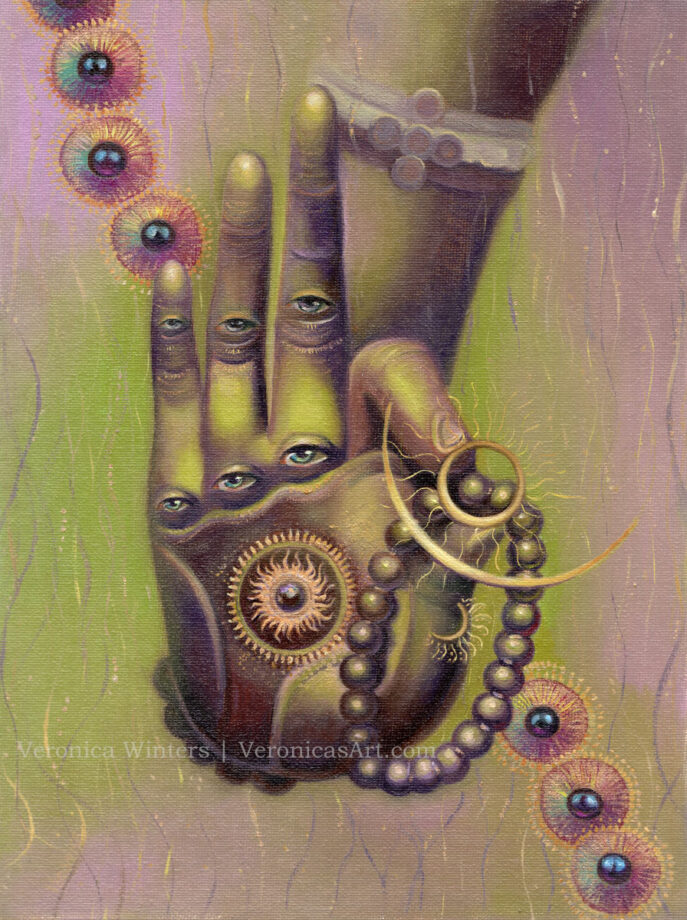
In terms of the visionary art techniques, the visionary style often involves meticulous attention to detail and the use of various tools and materials to create textures, repeated patterns, geometric designs and mirrored images. Many visionary artists also incorporate various digital technologies into their work, such as 3D modeling and digital painting software. However, not all visionary art is created in this style, and not all art created in this style is necessarily visionary in content.
Subjects:
A lot of visionary artists combine figurative art like a female figure, portrait or humans with the natural world, space and architecture. Even the still life subjects like books can become alive with images of ethereal worlds coming out of their pages.
- Spiritual and mystical themes: Many visionary artists draw inspiration from spiritual and mystical traditions, and their work often features imagery related to themes such as meditation, enlightenment, and transcendence.
- Nature: The natural world is a common subject in visionary art, with many artists drawing on the beauty and complexity of natural forms to create geometric shapes and designs and combine those with the animals, birds and plants.
- Altered states of consciousness: Many visionary artists are interested in exploring the nature of consciousness and the ways in which altered states of consciousness can give rise to new forms of perception and understanding.
- Mythology and symbolism: Many visionary artists draw on mythological and symbolic imagery to explore themes related to the human experience, such as birth, death, and transformation.
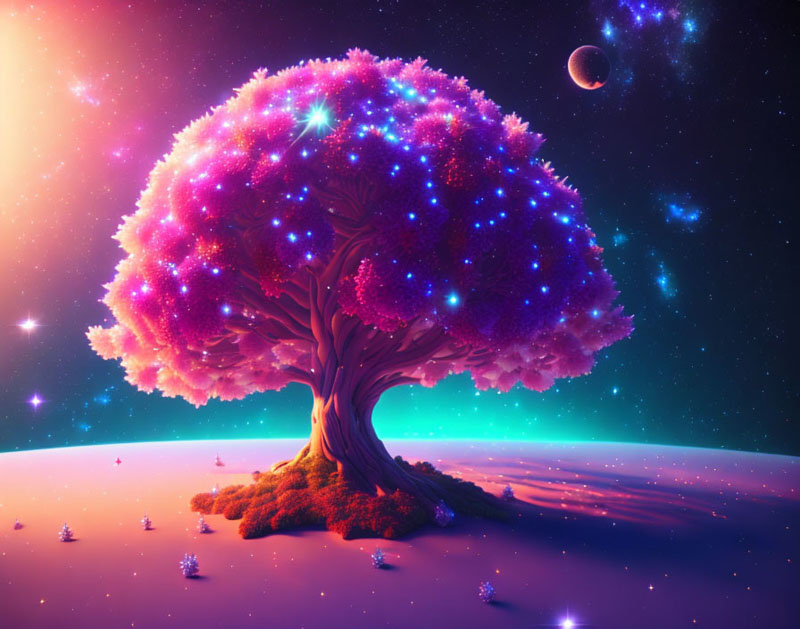
What are visionary art styles or types of visionary art?
There are several types of visionary art, each with its own unique aesthetic qualities and characteristics. Some of the most common visionary art styles include:
- Fantastic Realism: This style emphasizes highly detailed, realistic renderings of surreal and dreamlike imagery. The works often feature complex compositions.
- Psychedelic Art: This style emerged in the 1960s and is characterized by super bright, almost acidic colors and abstract, repetitive or mirrored patterns. The works often explore themes related to altered states of consciousness and the spiritual dimensions of psychedelic experiences.
- Digital Art: With the advent of digital technologies, many visionary artists have begun to explore new forms of expression using digital tools and techniques. This can include digital painting, 3D modeling, and other forms of computer-generated imagery. It’s easier to re-create complex geometric designs using the software rather than trying to paint the geometry.
- Sacred Art: This style is inspired by religious and spiritual traditions and often features iconic imagery, such as mandalas, sacred geometry, and depictions of deities and mythological figures.
- Surrealism: This style emphasizes the exploration of the unconscious mind and often features dreamlike imagery and unexpected combinations of objects and forms. The subjects are often depiction of dreams.
- Visionary Abstraction: This style is characterized by abstract imagery that is inspired by visionary experiences or altered states of consciousness. The works often feature complex patterns and textures, as well as a strong sense of movement and energy.
Art supplies artists use to create visionary art:
Visionary art is a diverse genre that encompasses a wide range of materials, tools and subject matter.
Materials:
- Paints: Many visionary artists use traditional painting materials such as oil, acrylic, and watercolor to create their works.
- Drawing materials: Pencils, pens, markers, and other drawing materials can be used to create detailed, intricate images.
- Mixed media: Many visionary artists combine different materials and techniques to create multi-layered and textured works of art. This can include collage, assemblage, and sculpture.
- Digital tools: With the rise of digital technology, many visionary artists are using digital tools such as digital painting software like Photoshop, Illustrator and Procreate and 3D modeling programs to create their work. AI programs include Midjourney, Stable Diffusion, Deep Dream Generator and many more.
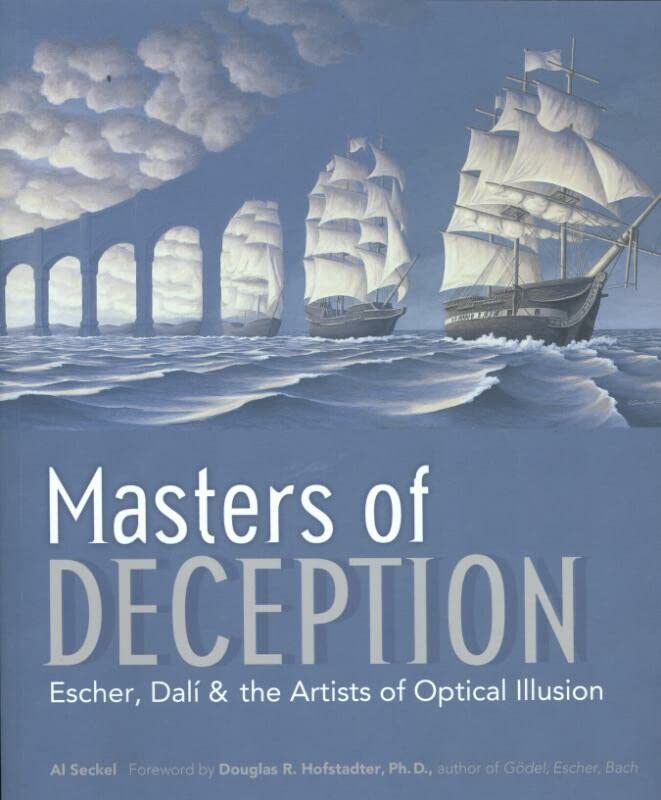
Is there a difference between spiritual art and visionary art?
These terms are often interchangeable and overlap each other. Spiritual art is created with the intention of expressing or exploring spiritual themes or experiences. This can include religious art that is created within a specific religious tradition, as well as other forms of art that explores broader spiritual themes such as the search for meaning and purpose, the interconnectedness of all things, or the nature of consciousness. Visionary art a specific genre of art that is characterized by highly detailed, surrealistic imagery and geometric forms and patterns that is intended to evoke spiritual or mystical experiences. While visionary art may explore spiritual themes, it is often more concerned with depicting the visionary experiences of the artist or viewer, rather than with conveying specific spiritual teachings or beliefs. In other worlds, spiritual art is a lot more encompassing because it can incorporate a very wide range of art.
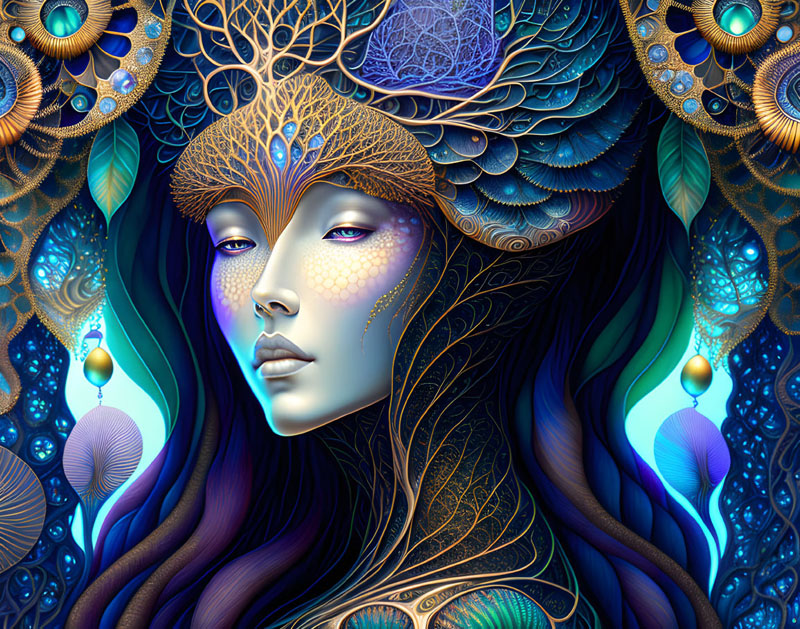
Why is vision important in art?
In essence vision in art doesn’t equal to the term as visionary art. Vision in art means to have a unique view of the world. Vision is unique to every artist because it is through our visual sense that we experience and interpret the world around us. Vision allows us to perceive and appreciate the colors, shapes, textures, and patterns that make up the visual world, and it allows us to appreciate the visual qualities of art. Vision can be used to create new ways of seeing and understanding the world. Visionary artists, in particular, use their vision to create works that challenge our conventional ways of perceiving the world and that invite us to explore new dimensions of experience and consciousness. This gives art unique meaning and depth.
In art, vision plays a crucial role in the creation and appreciation of visual images. Artists use their vision to translate their inner experiences and ideas into visual form, and they use their technical skills to manipulate color, light, and form in ways that create a particular mood or atmosphere.
For viewers, vision is important in art because it allows us to appreciate the visual qualities of art, such as the use of color, texture, and composition. Vision allows us to engage with the visual world of art, to appreciate the beauty and complexity of visual images, and to interpret the meanings and emotions that are conveyed through visual form.
Is it difficult to sell visionary art?
Visionary art can be difficult to sell for a number of reasons. Here are some factors that may contribute to the challenge of selling visionary art:
- Niche market: Visionary art is a relatively niche genre, and may not have the same level of mainstream appeal as more traditional art forms. This can make it more difficult for artists to find buyers for their work.
- Non-traditional styles and techniques: Many visionary artists use non-traditional styles and techniques in their work, which can be challenging for some buyers to appreciate or understand.
- Limited exposure: Because visionary art is a relatively new genre, it may not receive as much exposure in galleries or other exhibition spaces, which can limit its visibility and make it more difficult for artists to find buyers.
- Pricing: Because visionary art can be highly detailed and time-consuming to create, it may be priced higher than more traditional forms of art, which can make it more difficult to sell.
Despite these challenges, there is a growing community of collectors and enthusiasts who are interested in visionary art, and many artists have been able to successfully sell their work through online platforms, art festivals, and other venues that cater to this niche market. Additionally, as more people become interested in the transformative potential of visionary art, it is possible that the demand for this genre may grow in the future.
Visionary art museums & galleries around the world:
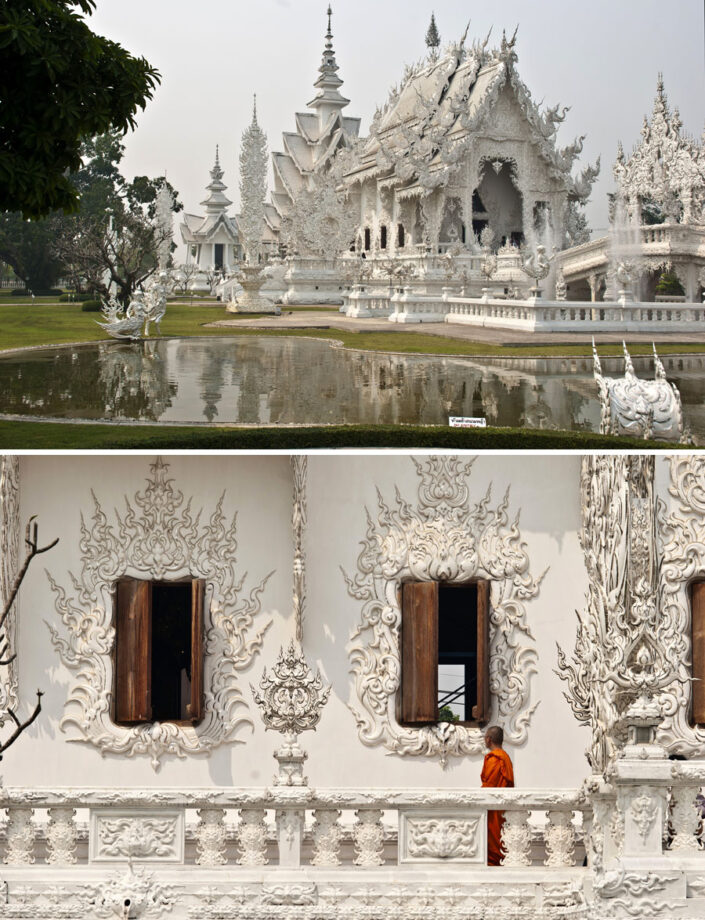
There are several museums and galleries around the world that specialize in visionary art, or that feature exhibitions of visionary art alongside other forms of contemporary art. Here are some examples:
- The Chapel of Sacred Mirrors (CoSM), New York, USA – CoSM is a sanctuary and exhibition space founded by visionary artists Alex Grey and Allyson Grey. The chapel features a permanent collection of Alex Grey’s artwork, as well as temporary exhibitions and events focused on visionary and spiritual art.
- The American Visionary Art Museum, Maryland, USA – This museum is dedicated to showcasing self-taught and visionary artists from around the world. The collection includes a wide variety of works, from traditional folk art to contemporary pieces that push the boundaries of what is considered “art.”
- La Casa de la Vision, Barcelona, Spain – This gallery specializes in visionary and psychedelic art, with a focus on emerging artists and underground movements.
- The Outsider Art Museum, Amsterdam, Netherlands – This museum features works by self-taught artists and outsiders, including many visionary artists. The collection includes both historical and contemporary works, and the museum often hosts special exhibitions and events focused on visionary art.
- The Museum of Visionary Art (Museum der Visionskunst), Frankfurt, Germany – This museum features works by international visionary artists, as well as artifacts related to visionary and spiritual traditions from around the world.
- The Visionary Art Museum of Belgium (Musée d’Art Fantastique), Brussels, Belgium – This museum features works by visionary and fantasy artists, as well as artifacts related to the history of visionary and fantastical art.
- Wat Rong Khun – the White Temple, is a privately owned and constructed Buddhist temple in Pa O Don Chai, Mueang District, Chiang Rai Province, Thailand. It is owned by artist Chalermchai Kositpipat, who designed and built it in 1997.
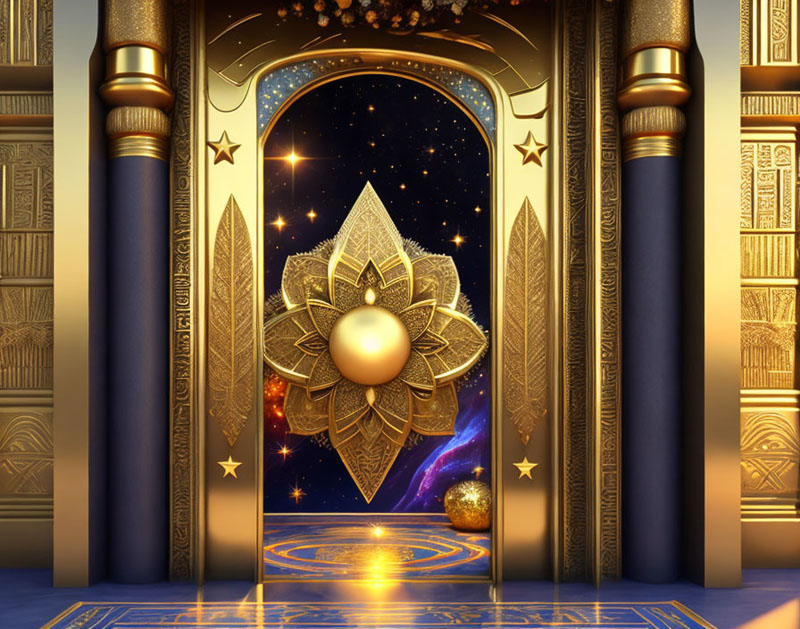
To read about psychedelic art and artists: https://veronicasart.com/psychedelic-art-guide-history-styles-music-spiritual-dimensions/